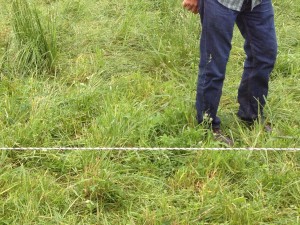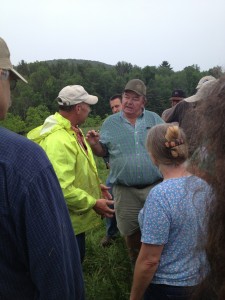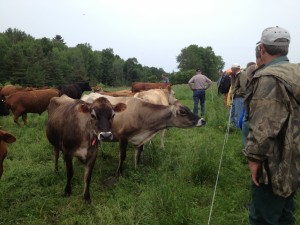Troy Bishopp, aka The Grass Whisperer
www.thegrasswhisperer.com, www.cnyrcd.org/planned-grazing-participants/
Wells, Vermont– In the coolness of a Vermont landscape etched with green pastures, green mountains and small farmers, stood a passionate rancher from South Africa ready to inspire others about the “whole” future of grass-based agriculture.
The internationally recognized, holistically-driven grazier, Ian Mitchell-Innes, is no namby-pamby in the opinion department which excited the capacity crowd of independent-minded farmers and conservation professionals about the merits of “managing with two generations in mind”. “We must work to nudge Mother Nature not club her over the head and move away from the 99% of agriculture that deals in parts”, said Mr. Innes. His message is catching on as the new USDA-NRCS Soil Health Initiative gets underway.
In his 3 month stay in America teaching countless ranchers and farmers about holistic decision-making and grazing management, he has seen a phenomenal change in the audience, with 80% being young farmers asking lots of questions concerning the status quo of conventional, linear thinking. “We’ve got to keep you farmers on the land by addressing root causes with management and not sending your money to town treating symptoms. If there’s a problem, it’s best to look in the mirror first before blaming. It’s high time to start managing towards what you want with what you have and change our bottom-feeder status in the community”, emphasized Ian.
Ian referred to the environment in which we work as “managing chaos” and on the importance of goal setting and holistic planning. “We are in the energy business: Energy is money, money is energy, and time is money, he said. For us to be successful, we must capture the free solar energy by converting plants through the grazing and trampling of the grass by animals and feed the soil with this carbon-based material. One day we will be recognized for our organic matter building capability by consumers around the world and be justly paid for sequestering carbon.”
Mr. Litter thinks all this can be accomplished by a vibrant grazing community working within a holistic management decision-making process adapted to your locale that concentrates on soil health, grazing management, animal performance, diversity, wealth generation from carbon and most of all—–having fun. To achieve this he focuses on improving the 4 ecosystem processes: The water cycle, the mineral cycle, energy flow and community dynamics (diversity). He uses planned grazing tools to make this happen.
His approach to grazing management that includes high density, taller grazing and only taking the top third of the plant with lots of “wasted grass” could be construed as contradictory to the intensive grazing/prescribed grazing model advocated in the Northeast but Ian defends his position by looking to the soil surface for answers.
“I’m suggesting, not telling, farmers to feed the carbon on the soil as well as getting top animal performance by grazing for energy and not for protein, which means grazing just the tops and letting the animals have more selection. Graziers need to get beyond the paralyzing paradigm of wasting grass if we want to be truly sustainable.”

How much are you trampling? The more plant matter trampled in to the soil, the more biological activity is being fed by the plant carbon. And the more plant matter being produced the next year.
After an enjoyable local lunch featuring NOFA-Vermont’s mobile pizza oven and all the fixins’, Ian led the large contingent of farmers into the pastures looking at trampling ratios, animal grazing behavior, rumen fill and soil health indicators while the animals were moved to a new paddock.
Hosts for the workshop, Richard & Cynthia Larson of Larson Farm & Morningside Stables in Wells, Vermont, are believers and practitioners in what Ian has taught them on their 120 acre, multi-species dairy, beef and equine operation. “He taught us to keep an open mind and be flexible with our management and gave us the tools to monitor our farm. We can see our land; animals and bank account improve and realize trampled forage as a true soil conditioner. We like being in the energy business”, said the Larsons.
Brian Maloney, a beef farmer and custom grazier, from Brylee Farm in Thurso, Québec traveled over 5 hours to get these new ideas and meet like-minded people. “I came to learn about the 80-20% trampling ratios and what they look like on the land and getting away from purchasing hay. I came away being punch-drunk by having all my preconceived paradigms broken”, he said.
Massachusetts Conservation District Professional, Bruce Howlett attended as part of his training through a NESARE professional development project in working with farmers on holistic planned grazing. “I came to hear more about mob-grazing and how it can relate to my small farm customers. I left with a better understanding of how trampling and feeding the soil as an essential part of the whole grazing system. It was eye-opening experience.”
Jenn Colby, UVM/Vermont Pasture Network and NESARE PDP Grazing Training Coordinator indicated she was absolutely thrilled with the turnout and ideas exchanged. “To have grazing and land management concepts from all over the world brought to my home state is awesome. It helps me realize I’m on the right track with looking at wholes. For me, Ian stitched all the threads together.”
No grazing event worth its salt could end properly without first enjoying conversations and networking over some fine ice-cream from the Strafford Organic Creamery at Rock Bottom Farm in Strafford, Vermont. The holistic-minded rancher came to the area to initiate some different perspectives and thinking while getting folks away from the mindset of can’t. Ian commented, “It’s amazing to me to see the change of attitudes from the beginning of the day to the end. I think some paradigms have been trampled.”
The event was sponsored by the Central NY Resource Conservation and Development Council, Inc. in partnership with the Planned Grazing Training Project (“Utilizing Holistic Planned Grazing as a Regenerative Engine for Sustainable Agriculture” – funded by Northeast Sustainable Agriculture Research and Education;www.sare.org) and the UVM Center for Sustainable Agriculture.
To find more on planned grazing tools and techniques go to www.cnyrcd.org/planned-grazing-participants/ or contact Jenn Colby at (802) 656-0858. To see a conversation with Ian Mitchell-Innes, visit www.youtube.com/watch?v=I3r2cqNfkKs




Recent Comments